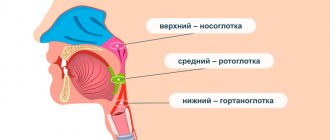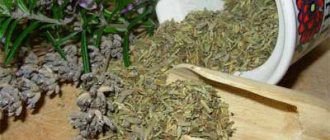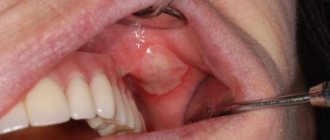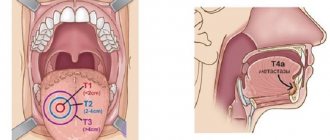Increased body temperature, painful sensations in the throat, weakness, headache - people usually attribute these symptoms in the spring-winter period to a common cold. However, often such signs indicate the development of a dangerous infectious disease, which doctors call purulent tonsillitis. The disease is manifested by severe inflammation of the tonsils (glands), located in the nasopharynx. The infection primarily affects the parenchyma and lymphoid tissue lining the tonsils. The disease is dangerous due to severe complications that develop when symptoms are ignored and there is no proper treatment.
If you suspect that you have a sore throat and need to consult a doctor, call +7 (499) 653-58-25 - we will definitely help you. Reception is carried out both in the clinic and with a visit to the patient’s home. To register online, fill out the form on the website.
Structure of the tonsils
The palatine tonsils, or tonsils, are an important organ of the human immune system. The tonsils are located in the oral cavity on both sides of the pharynx. The tonsils are shaped like an almond (hence the name “almond”) and range in size from one to four centimeters in diameter. The tonsils are endowed with a protective function. They are a kind of barrier to bacteria entering the body through airborne droplets, as well as through food intake. The structural features of the tonsils and the functions they perform are directly related to the appearance of tonsillitis plugs in the throat.
Make an appointment right now!
Call us by phone or use the feedback form
Sign up
On the surface of the tonsils, winding canals and openings are visible - lacunae and crypts.
When viruses from the outside enter the mouth, leukocytes in the tonsils are activated and begin an intensified process of forming antibodies that fight the “enemy.” At the same time, a signal is sent to all organs of the immune system, and the body comes into “combat readiness”.
Sources
- Alieva A.A., Harseeva G.G., Mangutov JO., Golovin S.N. // Klin Lab Diagn - 2022 - Vol63 - N6 - p.375-378; PMID:30702232
- Nomikos M., Barmpoutis P., Papakonstantinou E., Chousianitis Z., Ouzounoglou P., Efstathiadou P., Katsifotis C. A giant verrucous carcinoma of the penis presenting with urinary sepsis and angina. // Case Rep Med - 2014 - Vol2014 - NNULL - p.207026; PMID:25477967
- Dajer-Fadel WL., Borrego-Borrego R., Flores-Calderón O., Argüero-Sánchez R., Navarro-Reynoso FP., Ibarra-Pérez C. Descending necrotizing mediastinitis associated with spinal cord abscess. // Asian Cardiovasc Thorac Ann - 2013 - Vol21 - N1 - p.90-2; PMID:23430432
- Oda T., Yasunaga H., Matsumura Y., Watanabe G., Zaima Y., Takaseya T., Wada Y. Coronary artery bypass grafting in a patient with unstable angina pectoris and bronchiectasis. // Ann Thorac Cardiovasc Surg - 2014 - Vol20 Suppl - NNULL - p.761-4; PMID:23364226
- Dedov II., Terekhin SA., Kalashnikov VIu., Mitish VA., Doronina LP., Tokmakova AIu., Galstian GR., Melkozerov KV., Peretokina EV. [Single-step endovascular revascularization of the kidney, lower limb and endovascular reconstruction of abdominal aortic aneurysm in a patient with type 2 diabetic mellitus]. // Angiol Sosud Khir - 2012 - Vol18 - N3 - p.51-6; PMID:23059607
What is tonsillitis?
Tonsillitis is an inflammatory process in the tonsils. The disease can be acute or chronic. The acute form is better known as tonsillitis. In chronic cases, periods of exacerbation (inflammation of the tonsils) are replaced by a period of remission (calm). Most often, the disease occurs in children 5-15 years old, although adults are also susceptible to the disease. The tonsils in children are larger than in adults. The palatine tonsils reach their maximum size by the age of 7, and then begin to shrink. Constant viral attacks on the tonsils lead to tonsillitis. Chronic tonsillitis most often acts as a complication after an infectious disease (sore throat, caries, etc.). The chronic form of the disease, according to statistics, occurs in 5% of adults and 11% of children. That is, chronic tonsillitis is a common disease. Tonsillitis plugs on the tonsils often appear with chronic tonsillitis.
Consequences of purulent sore throat
Acute tonsillitis can occur with complications. They are usually divided into local and general.
Local complications:
- paratonsillar abscess - an abscess that forms outside the tonsil when infection penetrates into the surrounding tissue;
- acute otitis media – inflammation of the middle ear;
- acute laryngitis - inflammation of the larynx;
- cervical lymphadenitis – inflammation of the lymph nodes1.
General complications occur more often with streptococcal sore throat4, these include:
- rheumatism;
- rheumatoid arthritis;
- myocarditis;
- polyarthritis;
- glomerulonephritis and pyelonephritis;
- pneumonia and others1.
Up to contents
Causes of chronic tonsillitis
The chronic form of tonsillitis often develops as a complication after a sore throat. Many patients try to cure a sore throat on their own and take medications uncontrollably. Some, having received doctor’s recommendations, do not follow the instructions and finish the course of taking antibacterial drugs earlier than expected, noticing an improvement. This is a huge mistake! Untreated sore throat causes the disease to enter the chronic stage and the formation of tonsillitis with purulent plugs. The main causative agents of the disease are streptococci and staphylococci.
Exacerbation of tonsillitis is favored by:
- chronic inflammatory process (sinusitis, caries, sinusitis, etc.);
- proliferation of adenoids;
- deviated nasal septum;
- damage to the tonsils;
- hypothermia;
- weak immunity.
How to cure the disease?
In order for the child’s well-being to improve quickly, it is necessary to follow all the doctor’s recommendations. You can treat purulent sore throat in children by following a number of rules:
- drink plenty of fluids;
- take antibiotics, antipyretics and antihistamines;
- gargle;
- take vitamins;
- take eubiotics.
It is important not to carry out warming procedures if the child has a fever. Treatments include:
- compresses;
- warming creams and ointments in the neck area;
- inhalation.
These activities are not recommended if you are ill.
Your child needs plenty of fluids. Since he will sweat when drinking large amounts of fluid, it will be easier for the body to regulate body temperature, and bacterial toxins will be eliminated from it faster. Thanks to the consumption of fluid, it happens that there is no need to take antipyretic drugs or their use is canceled before the due date.
How to gargle a child's throat?
One of the main methods of treating sore throat is rinsing the throat, which can be used for children of the older age category, but for preschoolers and younger children, sprays and aerosols are used.
- Causes of knee arthritis in children, symptoms, diagnosis and treatment
Sprays include:
- orasept;
- Lugol;
- hexoral;
- miramistin;
- stopapangin;
- chlorophyllipt;
- antiangin;
- tantumverde;
- cameton.
These drugs are allowed to be used to treat sore throat in children over 2 years of age.
Rinsing is considered an auxiliary method, since antibiotics are the main thing in the cure.
For older children, you can prepare decoctions of various herbs for gargling, which have a mild anti-inflammatory effect.
- Chamomile.
- Sage.
- Calendula.
If you gargle frequently, you can eliminate the pain and restore the tonsils earlier than expected.
Rinsing is carried out 5 times a day for no more than 2 minutes. There is no need to carry out the procedure often and for a long time, due to the opposite effect occurring with constant vibration of the tonsils, their tissues will take longer to recover.
The following solutions are used for rinsing:
- 3% hydrogen peroxide solution;
- 1% iodinol solution;
- potassium permanganate;
- 2% boric acid solution;
- rotokan;
- stomatophyte;
- solution from furatsilin tablets;
- a solution of iodine, table salt, baking soda and water.
If the child cannot rinse the throat, then lozenges can be used.
- Septolete.
- Faringosept.
- Grammidin.
- Strepsils.
- Strepfen.
- Doctor Mom.
- Karmolis.
Medications
It is important to know that there is no quick cure for sore throat. Even if you are treated actively for 3 days, the results will be satisfactory. The minimum duration of illness is a week, the maximum is 14 days.
If, after taking the prescribed medications for 3 days, the child feels better, the fever has gone away, and an appetite has appeared, you should not deviate from treatment, as the microorganisms could simply hide. Therefore, in order to avoid new outbreaks of sore throat and prevent complications from developing, follow the doctor’s recommendations and take the medicine as much as prescribed in the prescription.
- Sore throat - treatment at home. Quick treatment of sore throat in adults
Many pediatricians recommend consuming B vitamins, vitamin C, and these can also be vitamin complexes.
- Centrum.
- Multitabs.
- Pikovit.
- Alphabet.
Antibiotics
Often, treatment of sore throat involves taking antibiotics of the amoxicillin group along with clavulanic acid.
- Augmentin.
- Amoxiclav.
- Ecoclave.
- Flemoclav.
- Solutab.
If the baby has an allergic reaction to penicillins, macrolides are prescribed.
- Sumamed.
- Cheromycin.
- Azitrox.
- Macropen.
It is necessary to treat purulent sore throat with antibiotics for at least a week. The doctor may also prescribe topical antibiotics. One of these is the Bioparox spray inhaler. It happens that sulfonamide antimicrobial agents are used, such as Biseptol, Bactrim. They are weak; bacteria do not often react to these drugs. If there is no result on the 3rd day, strong remedies are prescribed.
When treating with antibiotics, it is necessary to use eubiotics.
- Acipol.
- Bifidumbacterin Forte.
- Linux.
- Lactobacterin.
- Biobakton.
- Bifiliz.
- Acylact.
- Bifiform.
Medicines to reduce fever
Often, when you are sick, your body temperature rises. To bring it down, you can use the following medications:
- ibuprofen;
- paracetamol;
- calpol;
- efferalgan;
- mefenamic acid;
- Nurofen.
In addition to lowering the temperature, these agents have an anti-inflammatory effect.
The use of drugs to lower the temperature is allowed if it rises above 38 degrees. If the level is lower, you should not take them, since the body independently tries to fight the pathogen.
Taking antipyretic drugs should not exceed 3 days.
If you can’t get rid of the temperature with medications, you can try traditional medicine to solve the problem. To do this, you need to undress the child and wrap him in a diaper soaked in cold water. You can grind with an alcohol solution by mixing water and alcohol in equal quantities. You need to drink fluids more often. It can be like water, teas, compotes. The following will help increase sweating and reduce temperature:
- black currant;
- raspberries;
- cranberry;
- cherry.
Traditional methods
If purulent tonsillitis in children has been diagnosed, treatment at home can be carried out using traditional methods, but only with the permission of the pediatrician. Since, even using the well-known chamomile decoction to rinse the throat, it may not fit into the treatment regimen and slow down the patient’s recovery process. The methods used to treat sore throat at home complement the prescribed treatment by the pediatrician, and sometimes relieve signs of the disease.
Basically, treatment involves the use of medicinal herbs for rinsing. You need to drink teas:
- using raspberries;
- honey;
- lemon;
- mint;
- rosehip;
- linden;
- thyme;
- with cumin.
You can drink warm milk, adding honey and butter to it. It is necessary to treat the tonsils with a propolis solution.
Why do traffic jams occur with tonsillitis?
The main factor in the formation of purulent plugs on the tonsils is the constant presence of a focus of inflammation, provoked by viruses. There are always bacteria in the human mouth - they are not dangerous to health. Once in the gaps, they are killed by immune cells. The tonsils of a healthy person are capable of self-cleaning - dead microorganisms are removed from the lacunae and enter the stomach with saliva, where they are destroyed under the influence of gastric juice.
But as soon as dangerous viruses enter the body, a large number of leukocytes are sent to fight them, the mucous membrane of the tonsils swells, and self-cleaning of the lacunae under such conditions becomes difficult. Dead bacteria and leukocytes begin to accumulate in the tonsils - purulent-caseous formations appear. If you do not consult an otolaryngologist in time and do not begin treatment for purulent tonsillitis plugs, the process can become irreversible and lead to the destruction of the tonsils.
Purulent formations and chronic tonsillitis
In the chronic form of the disease, inflammation in the tonsils does not completely disappear, but only subsides for a while. Bacteria are always present in the lacunae of the tonsils, and the increased formation of a large number of leukocytes does not stop. Since the chronic form is characterized by the absence of pronounced signs of the disease, the appearance of purulent plugs goes unnoticed by the patient. White blood cells surround the bacteria, and a purulent formation appears. Over time, substances containing calcium and magnesium accumulate in them. As a result, the plugs harden.
Among the reasons for the formation of traffic jams are:
- diseases of the nasal cavity that are chronic (for example, sinusitis) - some of the bacteria from the nose certainly gets into the throat;
- lack of proper oral hygiene - here bacteria are constantly present and when immunity decreases, they enter the tonsils; food debris can also get stuck in the gaps and become “material” for the hardening of purulent masses;
- weak immunity - a person is unable to cope with the infection on his own, and the disease becomes protracted or chronic;
- damage to the tonsils - infection can easily get into the wound. Often it is the site of injury that becomes the location of a new purulent formation.
Symptoms of purulent plugs in the throat
Traffic jams are a factor by which chronic tonsillitis can be recognized. Therefore, when traffic jams appear, all the signs of this chronic disease are present. The following symptoms can be identified during an exacerbation of tonsillitis.
Constantly recurring sore throats - if there is inflammation in the tonsils, then this is not an indicator of chronic tonsillitis. But if a person is susceptible to the disease more than two or three times a year, then we can confidently say that we are dealing with a chronic form of the disease.
Friends! Timely and correct treatment will ensure you a speedy recovery!
The next symptom is redness and swelling of the palatine arches, to which inflammation from the tonsils can spread. Adhesions can form between the palatine arches and the tonsils - they seem to stick together with each other.
Enlarged lymph nodes are another sign of the disease. The manifestation of tonsillitis is accompanied by elevated body temperature. In the chronic form, a temperature of 37°C can last from several days to several weeks. The patient feels constant fatigue, lethargy, and performance decreases. All these are signals of adverse changes occurring in the body.
Symptoms of purulent plugs in the throat
The first sign is a feeling that there is something in the throat: like a lump; A dry cough may accompany these unpleasant sensations. The patient has difficulty swallowing and has a sore throat.
Severe pain in the throat is accompanied by a putrid odor from the mouth, which cannot be muffled even with the help of toothpastes. This smell is the result of the activity of bacteria accumulated in traffic jams. Caseous formations are also visible upon visual inspection - curdled tubercles of a white-yellow hue are immediately noticeable on the tonsils. It happens that the pustules are not immediately visible, but as soon as you press on the surface of the tonsil, for example, with your tongue, these white-yellow tubercles begin to appear.
Blockages in the tonsils can bring a lot of unpleasant and even dangerous consequences to the patient: if the infection travels with the blood or lymph flow further through the body, it can cause problems with the heart, kidneys and joints. In order not to have to treat complications from tonsillitis, it is necessary to get an appointment with an otolaryngologist in a timely manner and begin treatment for tonsillitis with purulent plugs.
Forms of the disease
The form of purulent tonsillitis depends on many associated factors and conditions. The most common three forms of development are follicular, lacunar and ulcerative-membranous (necrotic). Each type is characterized by characteristics of the course, specific lesions of the tonsil tissue and varying duration.
Follicular
Follicular tonsillitis is manifested by pinpoint purulent lesions of the parenchyma of lymphoid tissue and follicles of the tonsils. The disease in 85% of cases is caused by group A streptococci. The remaining cases of infection are associated with staphylococcal infection, Haemophilus influenzae, pneumococcus, and adenovirus. This form of pathology is accompanied by a rapid increase in the symptom complex, severe hyperthermia, sweating, loss of sleep and appetite. Intense pain in the throat can radiate to the ear.
Lacunarnaya
This type of disease causes severe inflammatory damage to the tissues of the peripharyngeal ring. The opening of abscesses is accompanied by the formation of specific perforations on the surface of the tonsils - lacunae. The acute phase of the disease is manifested by an increase in the size of the tonsils, up to difficulty breathing. Along with other symptoms, a characteristic sign of the lacunar type of pathology is bad breath. Sometimes doctors note a noticeable change in voice and diction problems. Inadequate therapy can lead to the development of a paratonsillar or retropharyngeal abscess.
Necrotic
Necrotizing ulcerative tonsillitis is rare (about 5-6% of cases). The main cause of the development of this type of disease is fusospirochetous infection. The rapid development of the infectious-inflammatory process causes the formation of histological changes in the tissues of the palatine tonsils. Violations of vascular permeability, associated with the active production of histamine and cytokines, lead to hypertrophy and sometimes tissue necrosis. The first sign of the disease is the feeling of a “lump in the throat.” Later, a sharp, unpleasant putrid odor appears from the mouth and salivation increases.
Treatment of tonsillitis plugs
The appearance of plugs indicates long-term inflammation occurring in the body, so the removal of purulent plugs must be combined with measures to treat chronic tonsillitis. Chronic tonsillitis should be treated by a competent otolaryngologist. Only an ENT doctor knows how to treat tonsillitis plugs effectively and safely. There is no need to try to get rid of pustules on your own at home. Many patients begin to put pressure on the tonsils, scraping off the “plaque” with a spoon and other improvised means. But this measure is ineffective - pus is removed only from the surface, but this is only the tip of the iceberg, the main problem is inside. Such inept actions often lead to injury to the tonsils, which will only provoke the appearance of new caseous formations.
Conservative method of removing tonsillitis plugs
Conservative treatment consists of:
- Treatment with medications (antibiotics and the duration of treatment is prescribed directly by the ENT doctor. Treatment of chronic tonsillitis should begin at the time of exacerbation, not remission. As a rule, the patient is prescribed the drugs “Amoxicillin”, “Amoxiclav”, “Summamed”, “Azithromycin”, etc. .).
- Gargling (solutions of furatsilin, soda, decoctions of chamomile, St. John's wort, string, from pharmaceutical products - Miramistin, Rotokan, etc. are excellent).
- Inhalations (as agreed with the doctor).
- Rinsing the lacunae of the tonsils (the most effective method for removing purulent accumulations. Performed only by an otolaryngologist. Rinsing is carried out using a syringe or a TONZILLOR device.
When carrying out a course of rinsing, the patient's condition significantly improves, the tonsils look healthier, and are cleared of purulent accumulations.
With chronic tonsillitis, the period of remission of the disease increases.
Medicinal preparations for rinsing
It is easy to get rid of purulent plugs with plain water, but it is recommended to use medications to rinse the throat. This remedy will remove plaque, destroy the causative agent of the disease and improve the condition of the mucous membrane during a sore throat.
There are several common preparations for rinsing with purulent sore throat.
- Potassium permanganate. To prepare the liquid, you will need to dissolve a couple of potassium permanganate crystals in 200 ml of warm water. The dosage is calculated for one rinse. It is recommended to filter the solution so that the grains do not scratch the already affected throat. Rinsing is carried out 4 times a day.
- Saline solution. For a sore throat, this is the most popular remedy; to prepare it, you need to dilute 1 tsp in 200 ml of warm water. soda and salt. For a quick effect, add a couple of drops of iodine to the liquid. The procedure is carried out 4 times a day, combined with other medications.
- Boric acid. To prepare the solution, pour 2.5 grams of 1% dry product into a glass of warm water. The liquid is used for rinsing with ulcers 3 to 5 times a day.
- Chlorophyllipt. The natural-based drug has an anti-inflammatory, immunostimulating and restorative effect. Add 1 tsp to a glass of warm water. medical product. It is necessary to gargle three times a day; it perfectly removes surface deposits.
- Furacilin. The drug tablet is crushed and dissolved in a glass of warm water. The product is used 2 to 4 times a day.
- Chlorhexidine. The drug has an antiseptic effect. Before using it, it is recommended to gargle with warm boiled water and brush your teeth. For the procedure, take a 0.05% solution, which you need to gargle for 30 seconds and spit it out.
It is prohibited to use different medications for purulent sore throat without first consulting a doctor. Some products can be harmful to the body. Inhalipt, due to its increased viscosity, slows down the discharge of pus.
Surgery
Tonsillectomy - removal of the tonsils - is the most radical way to get rid of the problem. It is used in the most extreme cases, when conservative methods do not bring the desired relief, and the indications for surgery must be quite serious. Before removing tonsils, you need to carefully weigh everything and first try a full range of conservative treatment measures. By removing the tonsils, you are deprived of a natural natural barrier against viruses and infections. You need to fight to preserve your tonsils to the last!
Tonsils are removed using a scalpel, laser or liquid nitrogen. Your ENT doctor will definitely tell you about all the intricacies and consequences of tonsillectomy.
Traditional medicine and preventive measures
Treatment with folk remedies for removing accumulated pus is not entirely effective - plugs located deep in the tonsil cannot be removed. With their help, you can only soften the surface of the plugs to facilitate their rejection and use herbal decoctions when gargling and disinfecting it.
To reduce the risk of traffic jams, you need to follow some simple tips:
- carefully monitor oral hygiene;
- treat sore throat and inflammation in the nose and mouth in a timely manner: sinusitis, frontal sinusitis, caries, stomatitis;
- avoid hypothermia;
- for chronic tonsillitis, follow the recommendations of your ENT doctor, do not forget about preventive complexes of physiotherapy and tonsil rinsing;
- Strengthen your immune system and try to lead a healthy lifestyle.
Treatment at the ENT Clinic of Doctor Zaitsev
Many years of experience of our doctors allows us to say with confidence that treating chronic tonsillitis is our specialty. The modern equipment of the clinic allows for effective and safe manipulations to treat tonsillitis and remove purulent plugs. Washing of the tonsils is carried out using all methods known in practice, including using a modified TONSILLOR nozzle, which has no analogues in other medical institutions. This is the know-how of our clinic. The modified attachment is much more effective than the usual one, completely safe, its use does not cause pain to the patient and is suitable even for small children.
Please make an appointment and come. We will be happy to help you.
Washing of the palatine tonsils in a clinical setting
Moscow clinics offer patients 2 highly effective options for hardware cleaning of the tonsils:
- vacuum, using the Tonsilor device;
- deep washing, combining hardware cleaning with phonophoresis and ultrasound.
Both methods help not only to cure the acute stages of ENT diseases, but also to get rid of chronic tonsillitis.
Vacuum rinsing of tonsils
The hardware method of cleansing the tonsils is a procedure that brings discomfort to the patient. To reduce pain, an anesthetic is used (usually the drug Lidocaine).
The duration of the manipulations is up to 10 minutes.
The procedure flow is as follows:
- the patient is asked to take a sitting position, tilt his head down, stick out his tongue;
- a special device with which the device is equipped is applied to the patient’s lymphoid accumulations;
- Using a vacuum, purulent deposits are removed from the ducts.
The course of therapy usually includes up to 10 rinses (in difficult cases, treatment is extended for another 5 procedures). After recovery, to achieve a prolonged effect, experts recommend repeating the vacuum cleansing procedure after 12 months.
You can see how the treatment procedure occurs in the video:
Contraindications to the use of this method in treatment regimens are: pregnancy, oncopathologies, retinal detachment, atherosclerosis, pulmonary tuberculosis.
Ultrasonic exposure
Excellent results in the treatment of tonsillitis are shown by deep cleansing of lymphoid accumulations. The liquefaction of purulent accumulations and the death of pathogens is caused by ultrasound (frequency - 26.5 kHz). The process is complemented by the introduction of medicinal drugs into the lymphoid tissue (phonophoresis). Before carrying out the procedure, you should watch a video about the main stages of Tonsilor therapy:
Timely treatment of inflammatory diseases of the ENT organs significantly reduces the risk of pathologies. An integrated approach will allow you to completely get rid of problems
- not only washing, but also taking drugs that stabilize the immune system, as well as hardening.










